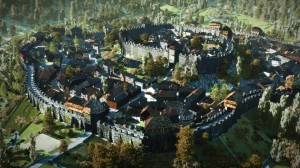ESRI adds City Engine to its portfolio to create 3D cities within ArcGIS and the company says it will continue development of City Engine as a standalone product.
One of the coolest companies to appear at Siggraph in recent years has been Procedural. It’s the cool company with a scary name. Procedural is a Swiss company and as the name suggests, they use procedural algorithms to generate cities. Procedural’s CityEngine has been used in movies including Pixar’s Cars2, in games, by architects and city planners. ESRI announced the acquisition of Procedural at their recent International User Conference in San Diego. ESRI CEO Jack Dangermond announced the acquisition at his keynote speech at the event. He described his company’s acquisition of the technology as a “game changer.” He told the audience, “this year we’re doing something dramatic, we’re acquiring a content creation company.”

Introduced as a technology presentation at Siggraph in 2001, Procedural’s CityEngine was introduced as a packaged product a few years later. To demonstrate the tools possibilities, Procedural exhibited a giant map of Pompeii. The company has been selling professional tools with a range of customization capabilities and most recently introduced Indie, a $500 product designed to be a push button tool to generate cities from GIS/CAD data.
Procedural’s tools also support OpenStreetMap, an open source, editable map of the world. Cities can be customized to be more (or less) realistic with tools to set up the procedural modeling rules. Street layouts can be defined as grid, organic, or circular, and custom textures can be added. The use of textures makes it possible to re-create recognizable landmarks in the city. It’s available as CityEngine Pro for $4950, CityEngine Studio for $1695, and CityEngine Indie $495. The company has also introduced an add-on for E-on’s VUE, a tool which generates 3D landscapes.
In his speech, Dangermond said the company plans to integrate it into its product ArcGIS so that ESRI’s customers can use their GIS data including parcels, street centerlines, etc to generate cities. The integration with ESRI will allow variables such as setbacks, and floor-specific zoning changes to be visualized. Dangermond told the audience that 3D is fast becoming a requirement in the GIS industry. “Many GIS problems can only be solved in 3D,” he said.
The company says they will continue to evolve and expand as a stand-alone product. Procedural’s Zurich offices will become an R&D center for ESRI where the team will explore the use of 3D content creation for urban design.
What do we think?
Procedural has developed technology with plenty of curb appeal. The company’s technology is something ESRI’s competitors could also put to good use. ESRI has snatched a key tool out from under the other GIS contenders.





